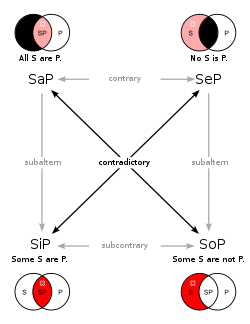Draft:Logical diagram
Submission declined on 2 August 2024 by SafariScribe (talk).
Where to get help
How to improve a draft
You can also browse Wikipedia:Featured articles and Wikipedia:Good articles to find examples of Wikipedia's best writing on topics similar to your proposed article. Improving your odds of a speedy review To improve your odds of a faster review, tag your draft with relevant WikiProject tags using the button below. This will let reviewers know a new draft has been submitted in their area of interest. For instance, if you wrote about a female astronomer, you would want to add the Biography, Astronomy, and Women scientists tags. Editor resources
|  |
| Submission declined on 10 July 2024 by SafariScribe (talk). This submission is not adequately supported by reliable sources. Reliable sources are required so that information can be verified. If you need help with referencing, please see Referencing for beginners and Citing sources. This draft's references do not show that the subject qualifies for a Wikipedia article. In summary, the draft needs multiple published sources that are: Declined by SafariScribe 4 months ago.
|  |
 Comment: Do you mean Logical flow diagram? Safari ScribeEdits! Talk! 14:22, 2 August 2024 (UTC)
Comment: Do you mean Logical flow diagram? Safari ScribeEdits! Talk! 14:22, 2 August 2024 (UTC)
A logical diagram is a diagram used to represent a logical proof, proposition or concept..[1]
[2]
History
[edit]The development of diagrammatic logic began with the square of opposition diagram created by Boethius and Augustine[3] based on the 4 categorical propositions "Some S are P", "Some S are not P", "No S is P" and "All S are P". No further advancements in diagrammatic logic were made until the invention of Euler diagrams in the 18th century. Euler diagrams were intended to serve as visual representations of the various Aristotelian moods[4]. The next advance in diagrammatic logic came in the form of the Venn diagram in 1880[5].
Pierce's Role
[edit]
The most significant advancement in graphical logic in the 19th century was made by American logician and philosopher Charles Sanders Peirce who in 1882 created a system of graphical logic[6] referred to as existential graphs composed of three subsystems the alpha, beta and gamma graphs. Peirce was dissatisfied with the existing logical notation and wanted to create a system in which the signs resembled what they represented.
Alpha graphs are isomorphic to Boolean algebra, beta graphs to first order logic with equality and gamma graphs are (partially) isomorphic to modal logic. Alpha graphs are both sound[7] and complete.
Modern developments
[edit]Semantic Tableaux
[edit]Semantic tableaux is a type of tree diagram which is used as a proof procedure for propositional and predicate calculus[8], a proof consists of splitting the given formula into several sub-formulae which are each either proven or refuted.
Conceptual Graphs
[edit]Conceptual graphs are a graphical representation of first order logic formulae[9]
Euler and Venn diagrams
[edit]Euler and Venn diagrams are a notation for set membership and intersection.[10][11] Venn diagrams were created to be a more expressive version of Euler diagrams for the purpose of teaching[5] and are now widely used in probability, statistics, logic and set theory.
Advantages
[edit]Diagrammatic logic is seen as a more intuitive notation than symbolic logic and because of this is commonly used as a teaching tool[12]. Proofs in existential graphs specifically are much shorter than symbolic proofs.
Disadvantages
[edit]Diagrammatic logic has been seen as being overly cumbersome,[13] complex and not suited for practical use in comparison to systems of symbolic logic.
See also
[edit]References
[edit]- ^ "What is Logic Diagram and Truth Table?". online.visual-paradigm.com. Retrieved 2024-07-09.
- ^ "logical diagrams". infocenter.sybase.com. Retrieved 2024-08-07.
- ^ Parsons, Terence. "The Traditional Square of Opposition". plato.stanford.edu. Retrieved 2024-07-10.
- ^ Shin, Sun-Joo; Lemon, Oliver; Mumma, John (2018), "Diagrams", in Zalta, Edward N. (ed.), The Stanford Encyclopedia of Philosophy (Winter 2018 ed.), Metaphysics Research Lab, Stanford University, retrieved 2024-07-10
- ^ a b Verburgt, Lukas M. (April 2023). "The Venn Behind the Diagram". Mathematics Today. Vol. 59, no. 2. Institute of Mathematics and its Applications. pp. 53–55.
- ^ Peirce, C. S., "[On Junctures and Fractures in Logic]" (editors' title for MS 427 (the new numbering system), Fall–Winter 1882), and "Letter, Peirce to O. H. Mitchell" (L 294, 21 December 1882), Writings of Charles S. Peirce, v. 4, "Junctures" on pp. 391–393 (Google preview) and the letter on pp. 394–399 (Google preview). See Sowa, John F. (1997), "Matching Logical Structure to Linguistic Structure", Studies in the Logic of Charles Sanders Peirce, Nathan Houser, Don D. Roberts, and James Van Evra, editors, Bloomington and Indianapolis: Indiana University Press, pp. 418–444, see 420, 425, 426, 428.
- ^ "Existential Graphs". www.jfsowa.com. Retrieved 2024-07-10.
- ^ Howson, Colin (1997). Logic with trees: an introduction to symbolic logic. London; New York: Routledge. pp. ix, x, 24–29, 47. ISBN 978-0-415-13342-5.
- ^ Sowa, John F. (1984). Conceptual structures : information processing in mind and machine. Internet Archive. Reading, Mass. : Addison-Wesley. ISBN 978-0-201-14472-7.
- ^ Shin, Sun-Joo; Lemon, Oliver; Mumma, John (2018), "Diagrams", in Zalta, Edward N. (ed.), The Stanford Encyclopedia of Philosophy (Winter 2018 ed.), Metaphysics Research Lab, Stanford University, retrieved 2024-07-09
- ^ "What is Euler Diagram?". online.visual-paradigm.com. Retrieved 2024-07-10.
- ^ "ReadingQuest Strategies | Venn Diagrams". 2009-04-29. Archived from the original on 2009-04-29. Retrieved 2024-07-12.
- ^ Quine, W. V. (February 1935). "Collected Papers of Charles Sanders Peirce.--Volume IV: The Simplest Mathematics. Charles Hartshorne, Paul Weiss". Isis. 22 (2): 551–553. doi:10.1086/346931. ISSN 0021-1753.



- in-depth (not just passing mentions about the subject)
- reliable
- secondary
- independent of the subject
Make sure you add references that meet these criteria before resubmitting. Learn about mistakes to avoid when addressing this issue. If no additional references exist, the subject is not suitable for Wikipedia.